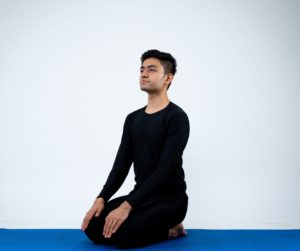 The Yoga of Eating – Getting Back to a Simple Life.
The Yoga of Eating – Getting Back to a Simple Life.
Our ancestors were on the right track—eating on the floor is good for us! They instinctively knew the yoga of eating. In most developed countries, people now sit on chairs to eat their meals. Yet the human body works best the way it was used for thousands of years: sitting cross-legged on the floor. In fact, when we eat in this position, it even aids our digestion.
When we sit on a chair, explains Brahmacharini Shobha, director of Amrita Yoga, “the spine is usually not very straight.
However, when we sit in Padmasana or half-lotus position, the spine naturally lifts and straightens. There is a feeling of openness and a sense of calm and the abdominal region including the stomach is unrestricted. This automatically triggers the signals to the brain to prepare the stomach for digestion. This is the yoga of eating. We feel our connection to Mother Earth. We are grounded.
Helping the Hips Relax
“Those who cannot sit directly on the floor may still benefit by sitting on a cushion or a low stool that raises the hips to a more comfortable place. Over time, you may find the hips relax enough to allow you to sit on the floor.
If you must use a chair, you may still be able to sit cross-legged on it. However, even sitting with just one leg crossed (knee opened out to the side, with the ankle on the other knee) has a positive effect on digestion.”
Brahmacharini Shobha explains that in India, it is traditional to leave the plate on the floor rather than to pick it up. The upper body moves forward to the food. “If you pick the plate up to eat, it is disrespectful to the food that is given to you,” she explains. “You are in need of food, so you go to it. There’s a feeling of humility.”
Seeing the Effort Made to Make Our Food
It is also a good time to consider how many people have toiled to bring you that food. She adds, “All that hard work and effort is right there. So it’s like we are prostrating. You go to it because you need it. It’s not that the food needs you. It teaches humility. The many times your hand goes down to the food, it’s as if you’re symbolically bowing down to all the people who have done all that hard work.”
As we repeatedly move forward and then back again, keeping the torso long and the spine straight, the gentle pumping action is very helpful for the digestion and stimulates the gastric juices.
Digestion requires good circulation of the blood to the digestive organs. Sitting cross-legged on the floor also helps the heart more easily circulate the blood than when the legs are extended down from a chair. The yoga of eating harmonizes our body as we enjoy our food. It’s best for the hips if we don’t always have the same foot on top each time we sit cross-legged on the floor. If the right foot is on top, Brahmacharini Shobha explains, more weight is borne by the right hip and vice versa. It’s good for all of us to alternate, to equalize the weight on both hips.
Eating the Correct Amount
Since we are eating more slowly, taking the hand down to the food and back up again, we may also feel full sooner, which helps us to avoid overeating. Sukhasana (the easy cross-legged pose with both ankles on the floor) and Padmasana also help our minds to feel relaxed and calm, which aids digestion and helps us to better enjoy the company of our family or friends.
Indians also traditionally eat with their fingers. “Each of the fingers represents a particular devata or demi-god or goddess,” Brahmacharini Shobha says. “So you’re invoking all of these. It also represents the panchaprana—the five vital airs. So you’re naturally bringing in all the five vital airs using the five fingers to consume the food. All five vital airs are important for the food to get digested.”
Traditionally the food is only touched with the last digit of each finger and the thumb, never with the palm of the hand. In spiritual homes, children are taught to eat without using the index finger, as it represents the ego. Other Indians may traditionally eat without using the little finger.
It may actually be more hygienic to eat with the fingers, as long as we wash our hands before eating. Brahmacharini Shobha says, “We can’t scratch our heads and touch this and that, and then eat.”
The Five Vital Airs
 For the best assimilation and absorption, all five vital airs of the body have to stay focused. “You’re consuming the food with five fingers and you’re offering it to the fire inside, like the fire mentioned in the 15th Chapter of the Bhagavad Gita—it’s like invoking that devata, the fire god in your stomach. “You’re offering all of this food to the fire pit in your stomach and it’s actually consumed by the fire god. Of the five elements—fire, water, air, earth and ether—fire can consume everything. When you offer it to fire, you can directly connect to that god who can assimilate, absorb, and then help with elimination. The rest of the gods will come and help, too. The yoga of eating connects us to positive subtle levels of reality.”
For the best assimilation and absorption, all five vital airs of the body have to stay focused. “You’re consuming the food with five fingers and you’re offering it to the fire inside, like the fire mentioned in the 15th Chapter of the Bhagavad Gita—it’s like invoking that devata, the fire god in your stomach. “You’re offering all of this food to the fire pit in your stomach and it’s actually consumed by the fire god. Of the five elements—fire, water, air, earth and ether—fire can consume everything. When you offer it to fire, you can directly connect to that god who can assimilate, absorb, and then help with elimination. The rest of the gods will come and help, too. The yoga of eating connects us to positive subtle levels of reality.”
Ayurveda also teaches that eating with the fingers aids digestion.
“During our meal is a good time to feel grateful that we are blessed with hands and that we have mobility and flexibility,” Brahmacharini Shobha adds.
In yoga, it is considered important to relax after eating, to allow the body to direct its energy to digest and assimilate nutrients. It is not the time to exercise, meditate or even lie down, as all these activities can hamper digestion.
 “However, there is one yoga posture that aids digestion,” Brahmacharini Shobha adds. “Vajrasana or diamond posture. One may sit in this pose for ten to fifteen minutes after eating. In this pose, your knees are together on the floor, and you are sitting back on your ankles. Although sitting on the floor or eating with the hands may initially seem challenging to those who have rarely done it, we may wish to try these practices and see whether we experience a benefit.”
“However, there is one yoga posture that aids digestion,” Brahmacharini Shobha adds. “Vajrasana or diamond posture. One may sit in this pose for ten to fifteen minutes after eating. In this pose, your knees are together on the floor, and you are sitting back on your ankles. Although sitting on the floor or eating with the hands may initially seem challenging to those who have rarely done it, we may wish to try these practices and see whether we experience a benefit.”
“If we think it might be helpful, we should try it,” Brahmacharini Shobha says. “The more frequently we practice, the more it becomes a habit and you don’t need to think about it.”
Do you enjoy sitting on the floor to eat? We’d love to hear how it works for you! Tell us your story about the yoga of eating.


I was not aware of these important benefits of eating on the floor and using the fingers – great article.
great article loves to read this.